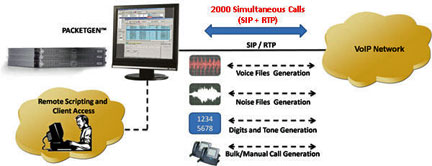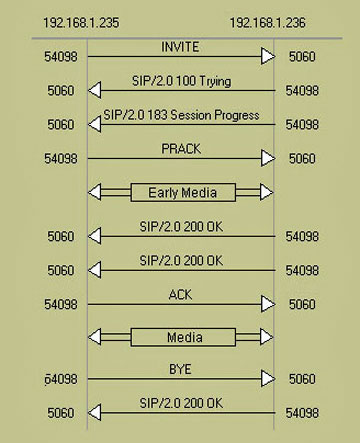GL Communications... Generating That Call... (Testing)
 [SatNews] GL Communications has announced Enhanced PacketGen™, a PC-based real-time...
[SatNews] GL Communications has announced Enhanced PacketGen™, a PC-based real-time...
...VoIP bulk call generator (both SIP signaling and RTP generation). Major applications include testing for stress, voice quality, digits, tones, voice files, and various codecs. PacketGen™ is based on a distributed architecture with SIP and RTP software cores modularly stacked in one or many PCs to create a scalable high capacity test system capable of generating 2000 simultaneous calls. PacketGen™ can be used to test basic functionality and verify proper protocol implementation in SIP based equipment such as SIP phones and Network Servers, Proxy Servers, Registrar Servers, and PSTN and Media Gateways.
Important Enhancement Introduced to PacketGen™:
High-Density Performance (2000 Simultaneous Calls)—PacketGen™ on an i7 PC can now support 2000 simultaneous calls with both SIP and RTP generation. This performance is with a G.711 codec, while other codecs may provide higher call densities. The distributed architecture of PacketGen™ allows achieving higher call rates and media streams, and provides greater scalability i.e. easy to add additional load generation capacity
Support for Additional Codecs —Additional codecs GSM-HR (Half Rate) and GSM-EFR (Enhanced Full Rate) are now supported.
Support for Multiple Frame Interval (Packetization Time - "ptime")—All supported codecs can operate with frame interval in multiples of minimum frame interval supported for the codec. For example minimum frame interval for AMR/AMR-WB is 20 msec, now we can operate with ptime like 40, 60, 80 msec.
Option to Enable or Disable VAD (Voice Activity Detection)—Provides option to enable or disable VAD for all VAD supporting codecs such as AMR, AMR-WB, HR and EFR.
Handles Media Re-Negotiation—Calls support media re-negotiation and are updated with media parameter changes like codec, port indicated during Re-INVITE or during call Off-Hold.
Supports REFER, NOTIFY and INFO Methods—Now calls can process REFER, NOTIFY and INFO methods during call and are replied with 200 OK responses.
Codec Support with an Enhanced Script Editor—Codec support for EVRC and EVRCB with Silence Suppression and G.711 Appendix II. RTP script editor feature helps users define multiple tones before monitoring receive tone action. The 'Tone Label' helps in identifying the type of tone detected. The user can trigger some actions like IVR applications based on the tone detected.
Reliable Provisional Responses (RPR)—The ability to send "reliable provisional responses" and start early media actions. We have two options in Reliable Provisional Responses Viz: Required and Supported. The diagram shows a SIP call flow with RPR's and early media.

Topical Tags :
Regional Tags :
 [SatNews] GL Communications has announced Enhanced PacketGen™, a PC-based real-time...
[SatNews] GL Communications has announced Enhanced PacketGen™, a PC-based real-time...


